Abstract
Inhibition of bacterial adherence to bladder cells has been assumed to account for the beneficial action ascribed to cranberry juice and cranberry juice cocktail in the prevention of urinary tract infections (A. E. Sobota, J. Urol. 131:1013-1016, 1984). We have examined the effect of the cocktail and juice on the adherence of Escherichia coli expressing surface lectins of defined sugar specificity to yeasts, tissue culture cells, erythrocytes, and mouse peritoneal macrophages. Cranberry juice cocktail inhibited the adherence of urinary isolates expressing type 1 fimbriae (mannose specific) and P fimbriae [specific for alpha-D-Gal(1----4)-beta-D-Gal] but had no effect on a diarrheal isolate expressing a CFA/I adhesin. The cocktail also inhibited yeast agglutination by purified type 1 fimbriae. The inhibitory activity for type 1 fimbriated E. coli was dialyzable and could be ascribed to the fructose present in the cocktail; this sugar was about 1/10 as active as methyl alpha-D-mannoside in inhibiting the adherence of type 1 fimbriated bacteria. The inhibitory activity for the P fimbriated bacteria was nondialyzable and was detected only after preincubation of the bacteria with the cocktail. Cranberry juice, orange juice, and pineapple juice also inhibited adherence of type 1 fimbriated E. coli, most likely because of their fructose content. However, the two latter juices did not inhibit the P fimbriated bacteria. We conclude that cranberry juice contains at least two inhibitors of lectin-mediated adherence of uropathogens to eucaryotic cells. Further studies are required to establish whether these inhibitors play a role in vivo.
Full text
PDF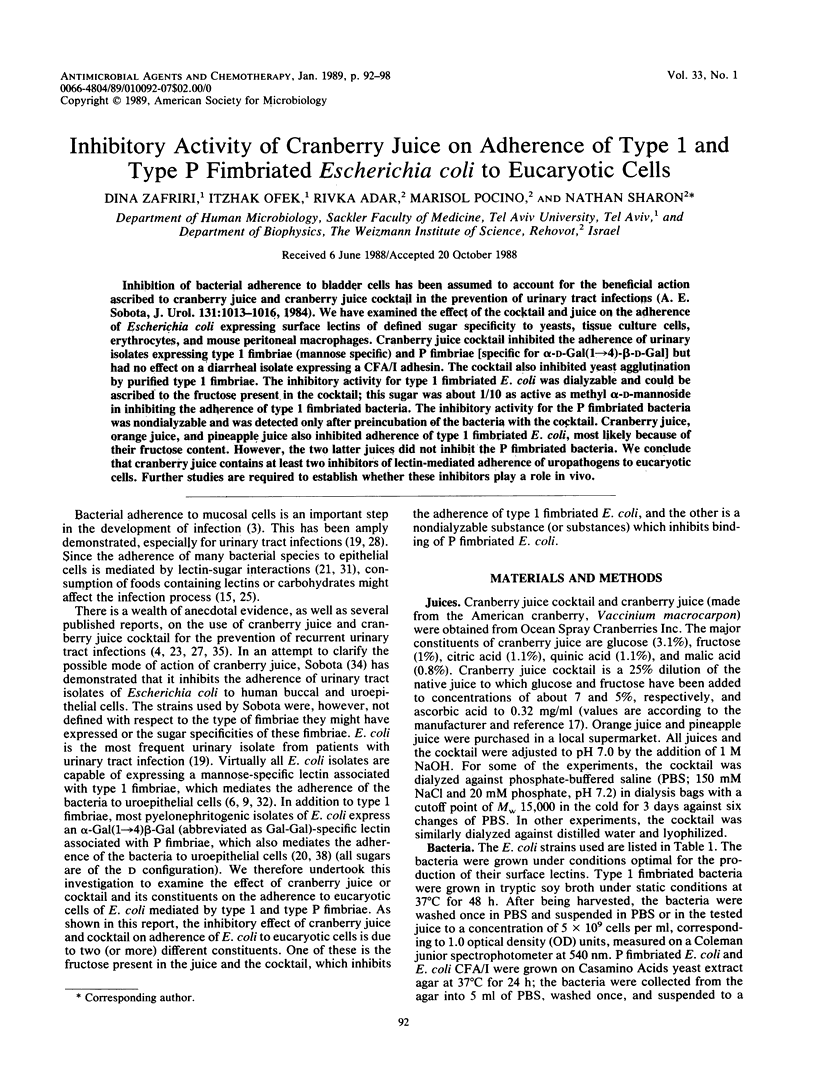
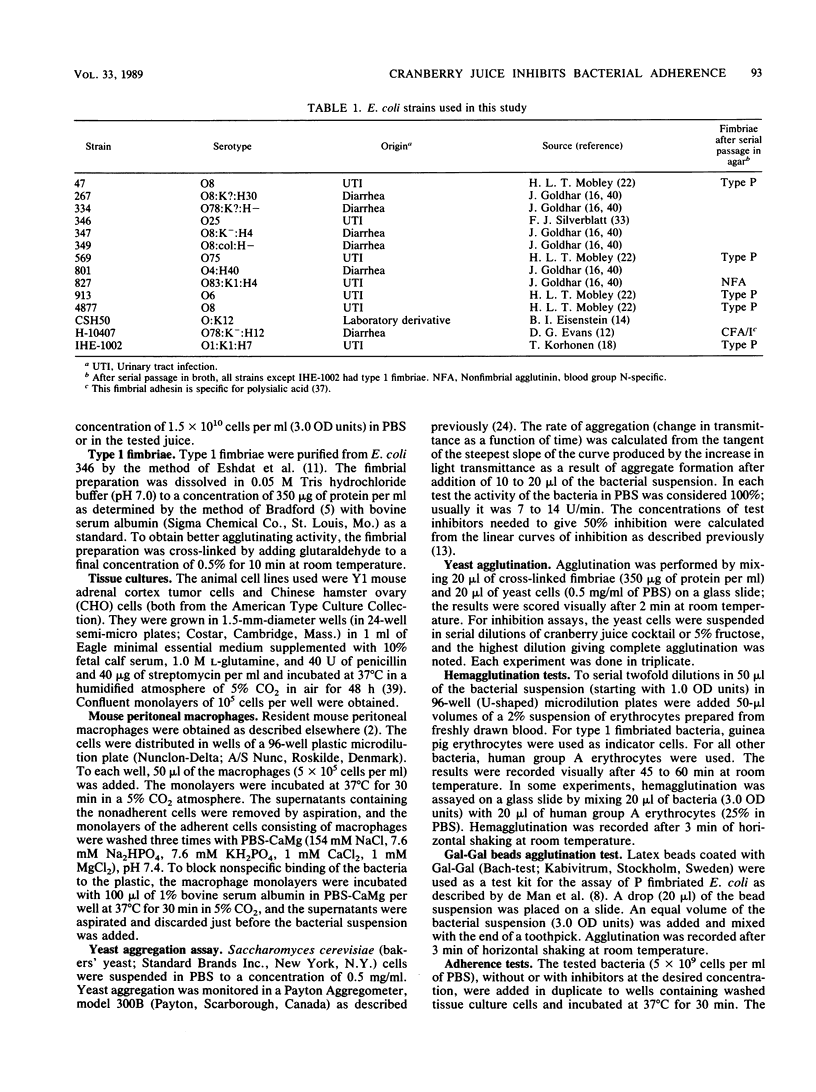
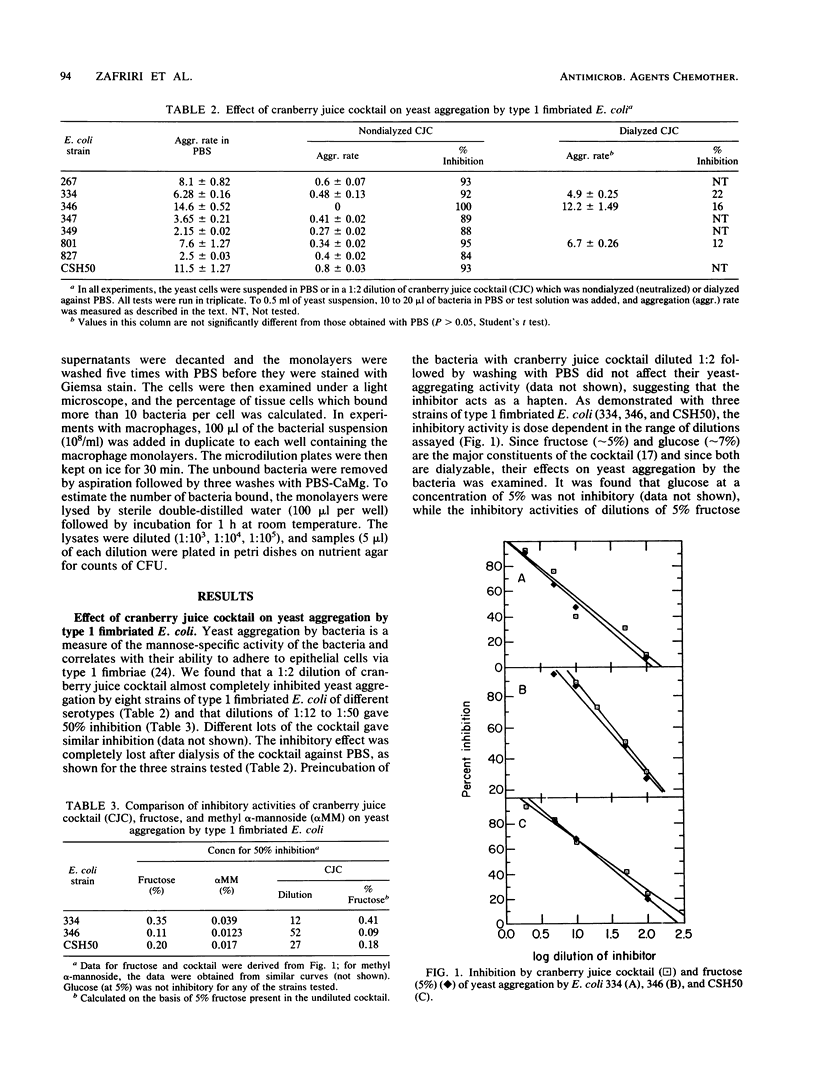
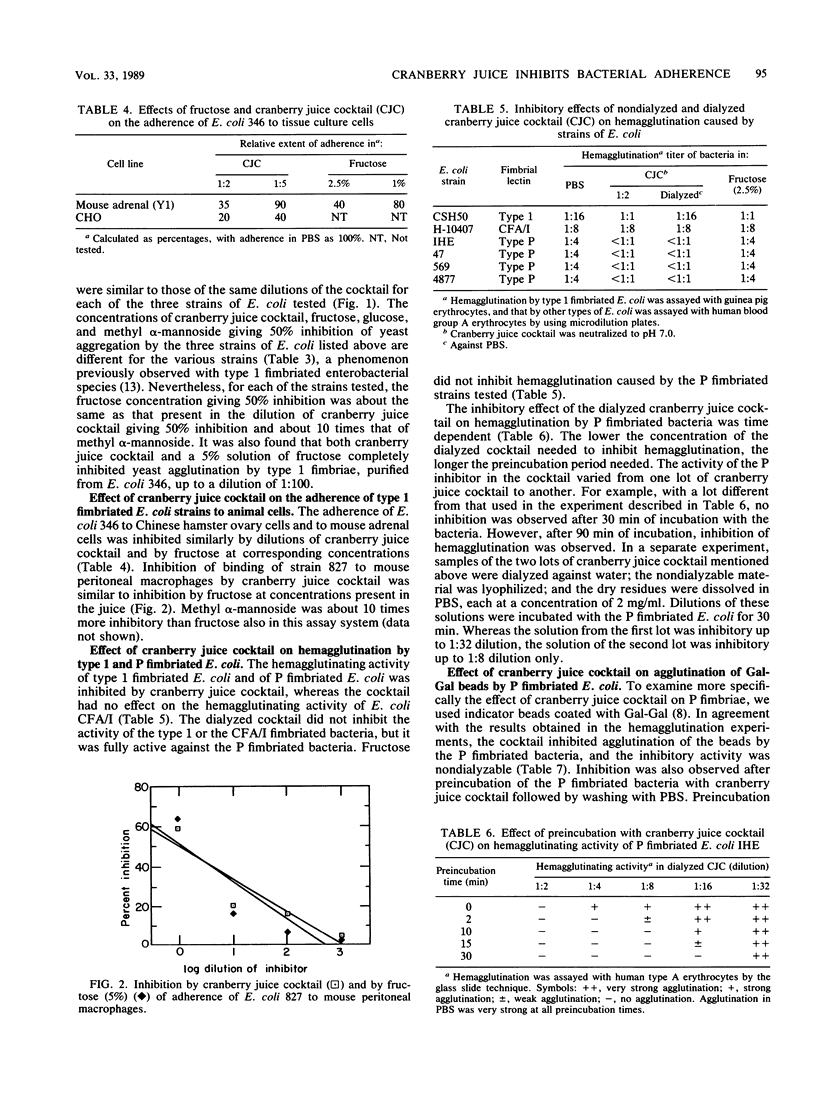
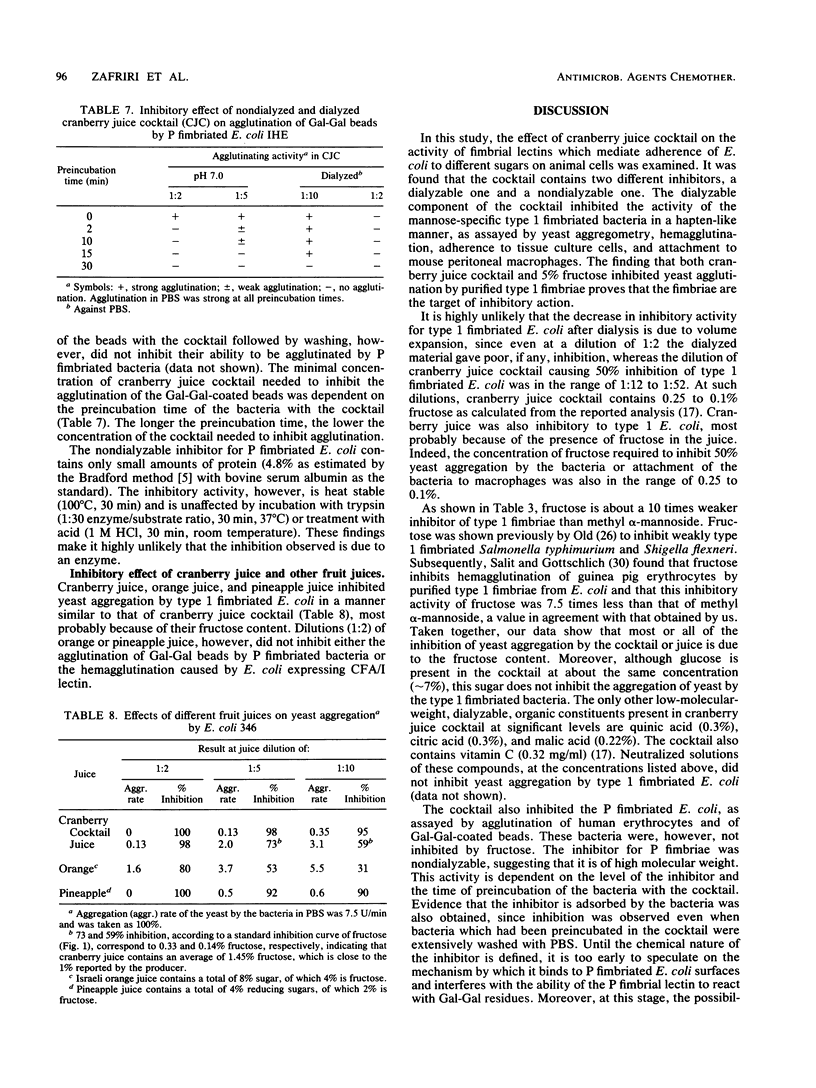
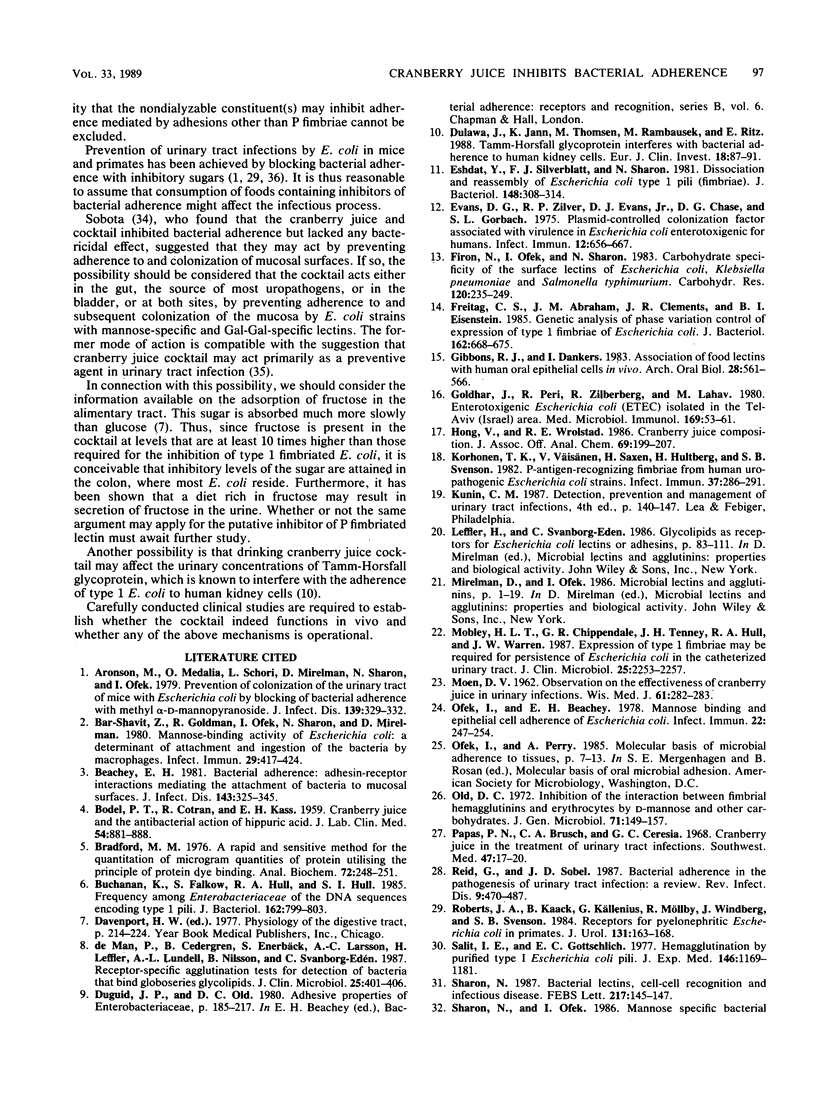
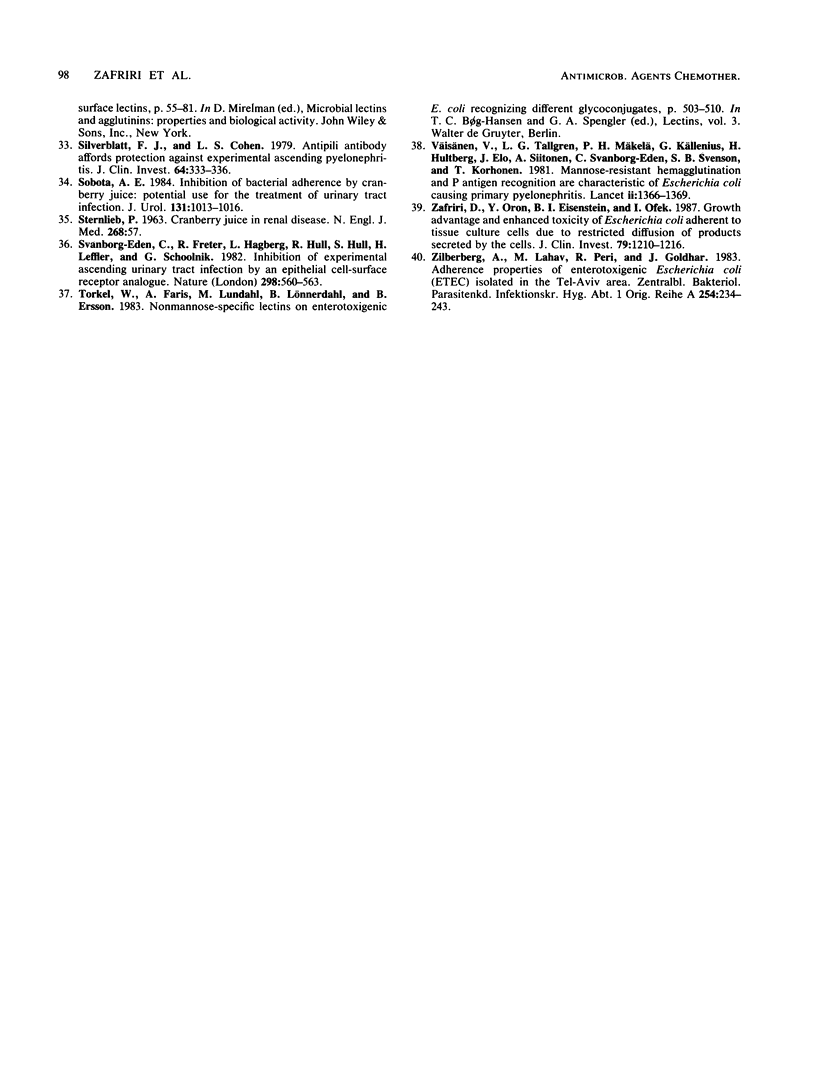
Selected References
These references are in PubMed. This may not be the complete list of references from this article.
- Aronson M., Medalia O., Schori L., Mirelman D., Sharon N., Ofek I. Prevention of colonization of the urinary tract of mice with Escherichia coli by blocking of bacterial adherence with methyl alpha-D-mannopyranoside. J Infect Dis. 1979 Mar;139(3):329–332. doi: 10.1093/infdis/139.3.329. [DOI] [PubMed] [Google Scholar]
- BODEL P. T., COTRAN R., KASS E. H. Cranberry juice and the antibacterial action of hippuric acid. J Lab Clin Med. 1959 Dec;54:881–888. [PubMed] [Google Scholar]
- Bar-Shavit Z., Goldman R., Ofek I., Sharon N., Mirelman D. Mannose-binding activity of Escherichia coli: a determinant of attachment and ingestion of the bacteria by macrophages. Infect Immun. 1980 Aug;29(2):417–424. doi: 10.1128/iai.29.2.417-424.1980. [DOI] [PMC free article] [PubMed] [Google Scholar]
- Beachey E. H. Bacterial adherence: adhesin-receptor interactions mediating the attachment of bacteria to mucosal surface. J Infect Dis. 1981 Mar;143(3):325–345. doi: 10.1093/infdis/143.3.325. [DOI] [PubMed] [Google Scholar]
- Bradford M. M. A rapid and sensitive method for the quantitation of microgram quantities of protein utilizing the principle of protein-dye binding. Anal Biochem. 1976 May 7;72:248–254. doi: 10.1006/abio.1976.9999. [DOI] [PubMed] [Google Scholar]
- Buchanan K., Falkow S., Hull R. A., Hull S. I. Frequency among Enterobacteriaceae of the DNA sequences encoding type 1 pili. J Bacteriol. 1985 May;162(2):799–803. doi: 10.1128/jb.162.2.799-803.1985. [DOI] [PMC free article] [PubMed] [Google Scholar]
- Dulawa J., Jann K., Thomsen M., Rambausek M., Ritz E. Tamm Horsfall glycoprotein interferes with bacterial adherence to human kidney cells. Eur J Clin Invest. 1988 Feb;18(1):87–91. doi: 10.1111/j.1365-2362.1988.tb01171.x. [DOI] [PubMed] [Google Scholar]
- Edén C. S., Freter R., Hagberg L., Hull R., Hull S., Leffler H., Schoolnik G. Inhibition of experimental ascending urinary tract infection by an epithelial cell-surface receptor analogue. Nature. 1982 Aug 5;298(5874):560–562. doi: 10.1038/298560a0. [DOI] [PubMed] [Google Scholar]
- Eshdat Y., Silverblatt F. J., Sharon N. Dissociation and reassembly of Escherichia coli type 1 pili. J Bacteriol. 1981 Oct;148(1):308–314. doi: 10.1128/jb.148.1.308-314.1981. [DOI] [PMC free article] [PubMed] [Google Scholar]
- Evans D. G., Silver R. P., Evans D. J., Jr, Chase D. G., Gorbach S. L. Plasmid-controlled colonization factor associated with virulence in Esherichia coli enterotoxigenic for humans. Infect Immun. 1975 Sep;12(3):656–667. doi: 10.1128/iai.12.3.656-667.1975. [DOI] [PMC free article] [PubMed] [Google Scholar]
- Firon N., Ofek I., Sharon N. Carbohydrate specificity of the surface lectins of Escherichia coli, Klebsiella pneumoniae, and Salmonella typhimurium. Carbohydr Res. 1983 Aug 16;120:235–249. doi: 10.1016/0008-6215(83)88019-7. [DOI] [PubMed] [Google Scholar]
- Freitag C. S., Abraham J. M., Clements J. R., Eisenstein B. I. Genetic analysis of the phase variation control of expression of type 1 fimbriae in Escherichia coli. J Bacteriol. 1985 May;162(2):668–675. doi: 10.1128/jb.162.2.668-675.1985. [DOI] [PMC free article] [PubMed] [Google Scholar]
- Gibbons R. J., Dankers I. Association of food lectins with human oral epithelial cells in vivo. Arch Oral Biol. 1983;28(7):561–566. doi: 10.1016/0003-9969(83)90002-x. [DOI] [PubMed] [Google Scholar]
- Goldhar J., Peri R., Zilberberg R., Lahav M. Enterotoxigenic Escherichia coli (ETEC) isolated in the Tel-Aviv (Israel) area. Med Microbiol Immunol. 1980;169(1):53–61. doi: 10.1007/BF02123712. [DOI] [PubMed] [Google Scholar]
- Korhonen T. K., Väisänen V., Saxén H., Hultberg H., Svenson S. B. P-antigen-recognizing fimbriae from human uropathogenic Escherichia coli strains. Infect Immun. 1982 Jul;37(1):286–291. doi: 10.1128/iai.37.1.286-291.1982. [DOI] [PMC free article] [PubMed] [Google Scholar]
- MOEN D. V. Observations on the effectiveness of cranberry juice in urinary infections. Wis Med J. 1962 May;61:282–283. [PubMed] [Google Scholar]
- Mobley H. L., Chippendale G. R., Tenney J. H., Hull R. A., Warren J. W. Expression of type 1 fimbriae may be required for persistence of Escherichia coli in the catheterized urinary tract. J Clin Microbiol. 1987 Dec;25(12):2253–2257. doi: 10.1128/jcm.25.12.2253-2257.1987. [DOI] [PMC free article] [PubMed] [Google Scholar]
- Ofek I., Beachey E. H. Mannose binding and epithelial cell adherence of Escherichia coli. Infect Immun. 1978 Oct;22(1):247–254. doi: 10.1128/iai.22.1.247-254.1978. [DOI] [PMC free article] [PubMed] [Google Scholar]
- Old D. C. Inhibition of the interaction between fimbrial haemagglutinins and erythrocytes by D-mannose and other carbohydrates. J Gen Microbiol. 1972 Jun;71(1):149–157. doi: 10.1099/00221287-71-1-149. [DOI] [PubMed] [Google Scholar]
- Papas P. N., Brusch C. A., Ceresia G. C. Cranberry juice in the treatment of urinary tract infections. Southwest Med. 1966 Jan;47(1):17–20. [PubMed] [Google Scholar]
- Reid G., Sobel J. D. Bacterial adherence in the pathogenesis of urinary tract infection: a review. Rev Infect Dis. 1987 May-Jun;9(3):470–487. doi: 10.1093/clinids/9.3.470. [DOI] [PubMed] [Google Scholar]
- Roberts J. A., Kaack B., Källenius G., Möllby R., Winberg J., Svenson S. B. Receptors for pyelonephritogenic Escherichia coli in primates. J Urol. 1984 Jan;131(1):163–168. doi: 10.1016/s0022-5347(17)50251-7. [DOI] [PubMed] [Google Scholar]
- Salit I. E., Gotschlich E. C. Hemagglutination by purified type I Escherichia coli pili. J Exp Med. 1977 Nov 1;146(5):1169–1181. doi: 10.1084/jem.146.5.1169. [DOI] [PMC free article] [PubMed] [Google Scholar]
- Sharon N. Bacterial lectins, cell-cell recognition and infectious disease. FEBS Lett. 1987 Jun 15;217(2):145–157. doi: 10.1016/0014-5793(87)80654-3. [DOI] [PubMed] [Google Scholar]
- Silverblatt F. J., Cohen L. S. Antipili antibody affords protection against experimental ascending pyelonephritis. J Clin Invest. 1979 Jul;64(1):333–336. doi: 10.1172/JCI109458. [DOI] [PMC free article] [PubMed] [Google Scholar]
- Sobota A. E. Inhibition of bacterial adherence by cranberry juice: potential use for the treatment of urinary tract infections. J Urol. 1984 May;131(5):1013–1016. doi: 10.1016/s0022-5347(17)50751-x. [DOI] [PubMed] [Google Scholar]
- Väisänen V., Elo J., Tallgren L. G., Siitonen A., Mäkelä P. H., Svanborg-Edén C., Källenius G., Svenson S. B., Hultberg H., Korhonen T. Mannose-resistant haemagglutination and P antigen recognition are characteristic of Escherichia coli causing primary pyelonephritis. Lancet. 1981 Dec 19;2(8260-61):1366–1369. doi: 10.1016/s0140-6736(81)92796-3. [DOI] [PubMed] [Google Scholar]
- Zafriri D., Oron Y., Eisenstein B. I., Ofek I. Growth advantage and enhanced toxicity of Escherichia coli adherent to tissue culture cells due to restricted diffusion of products secreted by the cells. J Clin Invest. 1987 Apr;79(4):1210–1216. doi: 10.1172/JCI112939. [DOI] [PMC free article] [PubMed] [Google Scholar]
- Zilberberg A., Lahav M., Peri R., Goldhar J. Adherence properties of enterotoxigenic Escherichia coli (ETEC) isolated in the Tel-Aviv area. Zentralbl Bakteriol Mikrobiol Hyg A. 1983 Apr;254(2):234–243. [PubMed] [Google Scholar]
- de Man P., Cedergren B., Enerbäck S., Larsson A. C., Leffler H., Lundell A. L., Nilsson B., Svanborg-Edén C. Receptor-specific agglutination tests for detection of bacteria that bind globoseries glycolipids. J Clin Microbiol. 1987 Feb;25(2):401–406. doi: 10.1128/jcm.25.2.401-406.1987. [DOI] [PMC free article] [PubMed] [Google Scholar]


